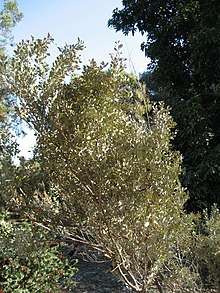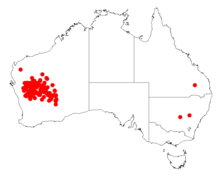Acacia craspedocarpa
Acacia craspedocarpa, commonly known as hop mulga[1] or the broad-leaved mulga,[2] is a shrub or tree in the family Fabaceae native to central parts of western Australia.
| Hop mulga | |
|---|---|
 | |
| Scientific classification | |
| Kingdom: | Plantae |
| Clade: | Tracheophytes |
| Clade: | Angiosperms |
| Clade: | Eudicots |
| Clade: | Rosids |
| Order: | Fabales |
| Family: | Fabaceae |
| Clade: | Mimosoideae |
| Genus: | Acacia |
| Species: | A. craspedocarpa |
| Binomial name | |
| Acacia craspedocarpa | |
 | |
| Occurrence data from AVH | |
Description
Hop mulga is a spreading or erect shrubby tree that typically grows to a height of 1.2 to 4 m (3 ft 11 in to 13 ft 1 in) but can grow as tall as 8 m (26 ft).[1] It has corky bark,[2] scurfy branchlets with resinous ribs and dark red-brown coloured new shoots. Like most Acacia species, it has phyllodes rather than true leaves. These are thick and bluish green in colour with a length of 1.5 to 2.5 cm (0.59 to 0.98 in) and a width of 8 to 12 mm (0.31 to 0.47 in). They have an orbicular to broadly obovate or oblong shape and have a rounded tip usually with three main longitudinal nerves.[3] The simple inflorescences occur singly in the axils with cylindrical clusters that have a length of 12 to 20 mm (0.47 to 0.79 in) and a diameter of 5 mm (0.20 in) and are packed with yellow coloured flowers.[4] The pods broad and flat seed pods that form after flowering resemble the pods of the hop plant.[5]
Distribution
It is endemic arid to semi-arid areas in the Mid West and western Goldfields regions of Western Australia, it occurs in watercourses, on floodplains, on flats, in low-lying areas and alongside rivers goring in red clay or loamy soils or on alluvium and stony red earth.[1]
Cultivation
The ornamental medium to tall plant is available commercially and grows well drained light to heavy soils in full sun or partial shade and is drought tolerant once it is established. It will also tolerate a light frost to around −8 °C (18 °F) It is quite long lived and can grow well in a container.[2]
See also
References
| Wikispecies has information related to Acacia craspedocarpa |
- "Acacia craspedocarpa". FloraBase. Western Australian Government Department of Parks and Wildlife.
- "Acacia craspedocarpa". Australian Native Plants. 2020. Retrieved 2 May 2020.
- "Acacia craspedocarpa". Flora of Australia Online. Department of the Environment and Heritage, Australian Government.
- "Acacia craspedocarpa". WorldWideWattle. Western Australian Herbarium. Retrieved 2 May 2020.
- Mitchell, A. A.; Wilcox, D. G. (1994). Arid Shrubland Plants of Western Australia, Second and Enlarged Edition. University of Western Australia Press, Nedlands, Western Australia. ISBN 978-1-875560-22-6.